You won't surprise anyone with a household vacuum cleaner today. These useful devices have been helping us to keep our houses and apartments in order for many years. Powerful construction vacuum cleaners are another matter. Our artisans: carpenters, installers of internal engineering networks and specialists engaged in the repair of housing and offices, got acquainted with this type of equipment not so long ago. Many, probably, still know about them by hearsay. The editorial staff of the site "bestx.htgetrid.com/en/" offers you an overview of "The best construction vacuum cleaners for 2020", compiled according to customer reviews and the opinion of experts.
Content
Who invented the vacuum cleaner
The first mechanical carpet cleaner was invented by American Daniel Hess from Chicago in 1860. The working body in it was a rotating brush. The debris was sucked in by the air flow from the bellows system and deposited in two containers with water. The device has become an analogue of a modern washing vacuum cleaner (for example, Thomas). The car turned out to be bulky. In addition, the manual drive took a lot of effort. It is not known whether this product would have been in demand, since the first developments did not have time to hit the market, having burned down in a fire in 1860.
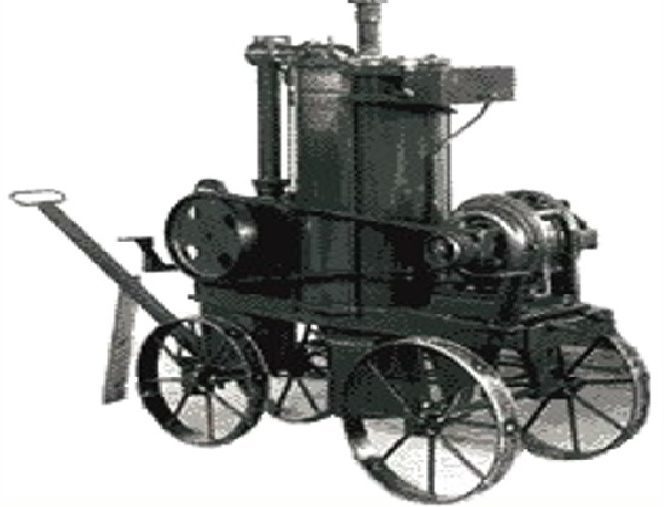
Eight years later, a device called Whirlwind appears in Chicago. Its inventor A. Mcgrafney equipped his brainchild with a manual drive with a belt drive for rotating a fan. The device turned out to be compact, lightweight and extremely inconvenient, since it was necessary to simultaneously push the machine and rotate the fan manually. Nevertheless, a year later, McGrafney receives a patent and starts production of his products in Boston.

British engineer Hubert Cecil Booth patented his device in 1901. The first devices were powered by a gasoline engine. Subsequently, the device received an electric drive. The design had such solid dimensions that it moved on horse-drawn traction.
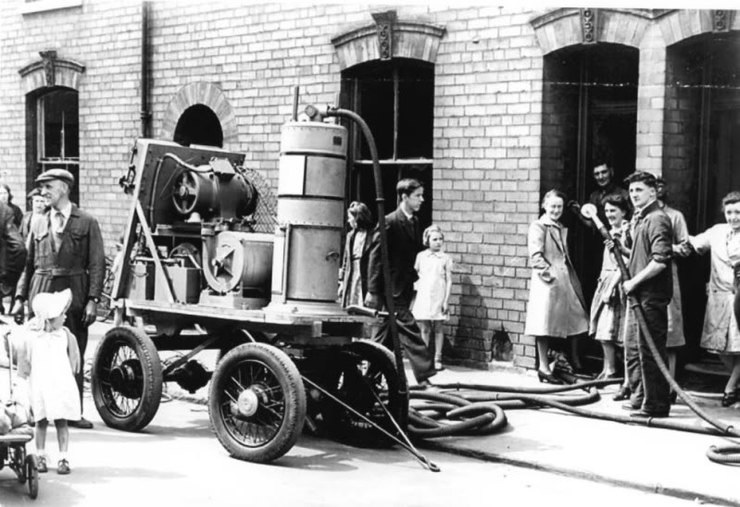
In 1907, Murray Sperling manages to create a portable apparatus with an electric drive and a pillowcase as a dust bag. The inventor, constrained in funds, could not organize production and decided to sell the patent. The buyer was his relative, William Hoover from Ohio, who founded the famous Hoover U.S. company in 1908.

Interesting! The word "vacuum cleaner" has two translations from Russian into English: vacuum cleaner and hoover!
After that, vacuum cleaners began to improve continuously. Cyclonic devices, devices with an aquafilter, washing devices and even robots appeared.
What is a construction vacuum cleaner for?
Construction and installation work is accompanied by the formation of a significant amount of construction waste and debris. Their timely removal from the working area is necessary for reasons of labor safety, ecology and organization of the workplace. Ultimately, keeping the workplace in order helps preserve the health of a specialist, increase his productivity and increase wages (if the payment is piecework).
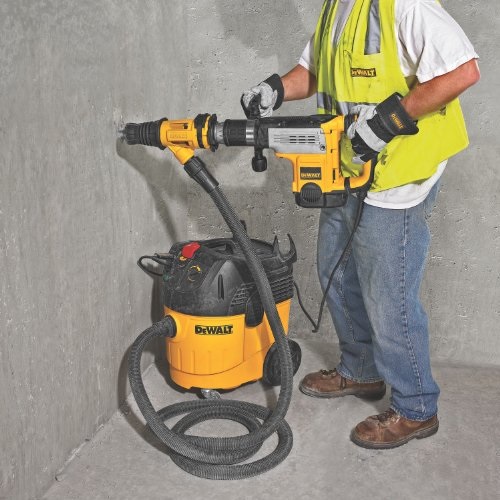
Removing construction debris and waste with a broom, broom and shovel is an unskilled work, low-paid, time-consuming for a specialist, which can be used with greater benefit for business. From this point of view, the importance of special equipment can hardly be overestimated. A powerful, sufficiently mobile device will help you quickly collect debris, spills of sand, cement, mortar, small stones and liquids from the floor. It is impractical to use a household unit for these purposes: the power is not enough, the dust bag is small, and it itself will not last long.
What are the vacuum cleaners
Dust bag devices
All vacuum cleaners work according to the same principle. The suction fan creates a pressure in the chamber behind the dust bag that is well below atmospheric pressure. The air surrounding the working body of the apparatus (brush) is under the influence of atmospheric pressure. When the engine is turned on, air from the room, together with debris, rushes into the low pressure zone and enters the dust bag. The bulk of the garbage remains in the bag, and the purified air, passing through the pores of the material, enters the fine filters, and then is released into the atmosphere.
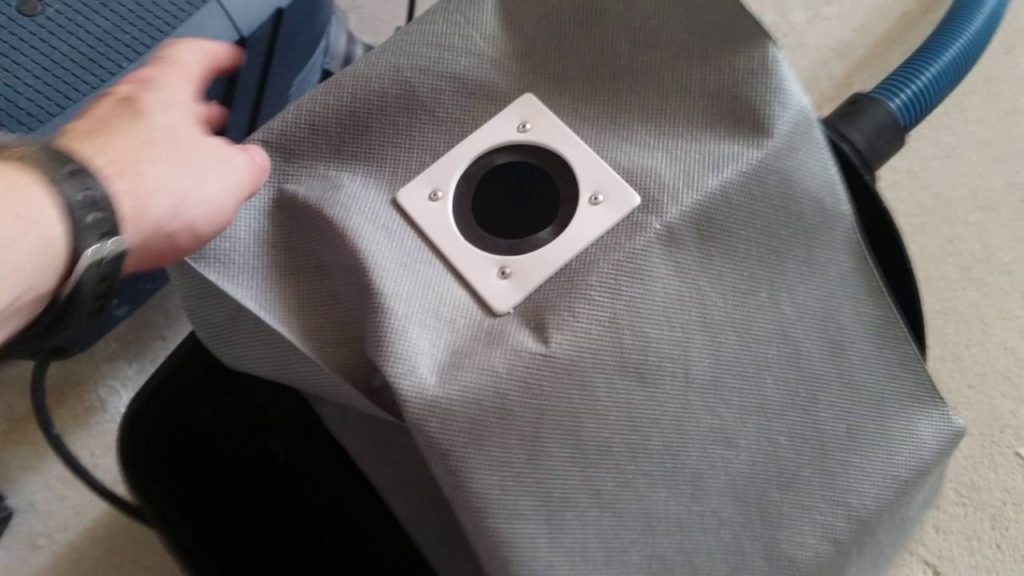
Some units can work without bags. In this case, the polluted air immediately enters the dust container located below the filter. This option is not suitable when removing fine dust, since a significant part of it is thrown back into the room.
Cyclones
In cyclone-type devices, instead of a dust bag, a special chamber is used in which the air flow is twisted in a spiral. Large and heavy particles of debris under the action of centrifugal force settle to the bottom of the dust collector. The air with residual dust content passes through the filter and is purified and discharged into the atmosphere.

Aquafilter
Here, a container with water acts as a bag and container for collecting dust. Most of the debris and dust is deposited in the water. Air with dust residues passes through fine filters and is released into the atmosphere. In terms of the degree of air purification, these are the most efficient devices. They are also distinguished by a solid price and great weight. The built-in pump easily turns a product with an aquafilter into a washing unit, which can be used to wash floors by adding a cleaning agent.

Built-in vacuum cleaners
Imagine a large country house. In a separate room (basement) there is the entire electromechanical part of the machine, together with a filter and a large waste collection container. In the walls, secretly, pipes equipped with wall inlets are laid into each room. For cleaning, you need to insert a flexible hose into the receiver of the wall inlet and turn on the engine. This is certainly convenient for a country house. Move the hose with the brush from room to room and connect, but there is also a downside to the coin:
- To create a sufficient vacuum in an extensive network of pipelines, the unit must be equipped with a powerful engine that consumes a large amount of electricity.
- Installation of such a device, in a place with hidden pipelines, will cost the owner dearly.
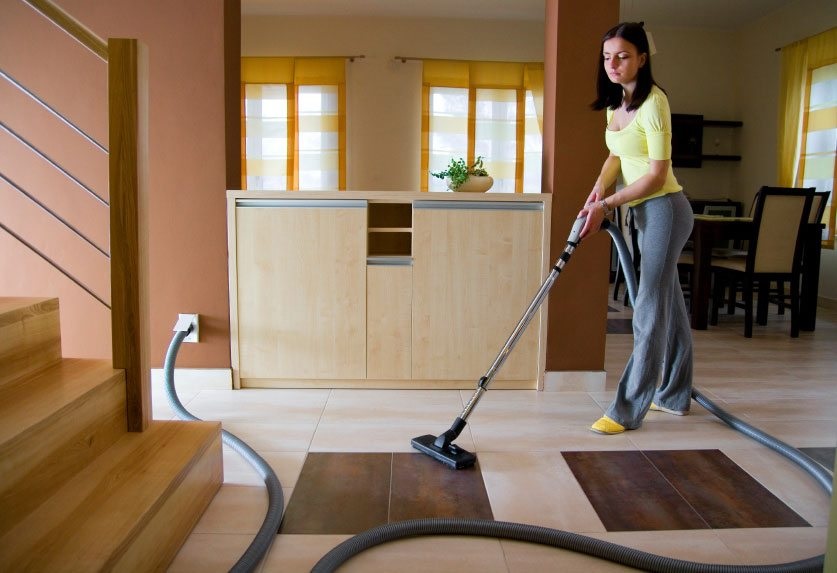
Robots
The popularity of these models is growing every day. Cleaning an apartment is a process that takes a lot of time and effort, but here you don't have to do anything yourself. You give a task to the machine and you can do other things. The robot will move around the apartment and do its job. It will stop only when not a speck of dust remains in the house or when the battery is discharged. From time to time, as the container fills up, the "smart guy" will give a signal that it is time to unload it.
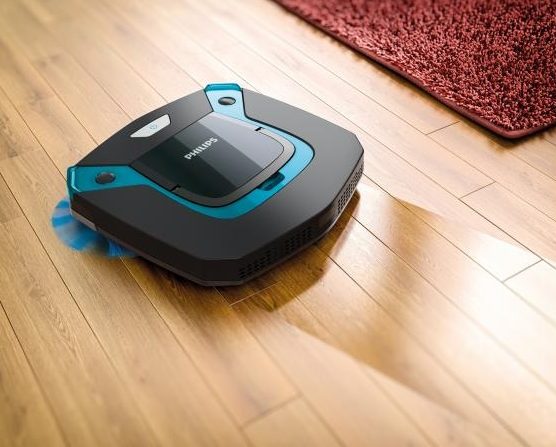
Interesting! Advanced machines, as the container is full, RETURN to the base on their own, dump the cargo into the tank and recharge the batteries, after which the process continues. In this case, the machine will stop when the tank at the base is full.
Construction vacuum cleaners
With their household counterparts, building units have the same device and the same principle of operation. But they solve different problems. Hence some of the differences in design.
A household vacuum cleaner easily “defeats” ordinary household waste. Stones, even of a small fraction, will not be mastered by every device. When it comes to fine compositions, such as cement, a significant part of them, having passed through all the filters, will fly back into the room, something will penetrate into the engine and cause it to break down.
The construction option is designed to remove just such waste, so it will not be damaged. The volume of waste, even with a single use, significantly exceeds the amount of garbage from cleaning the apartment. Hence the distinctive features inherent in construction vacuum cleaners:
- More spacious dust collectors;
- Rugged housings capable of resisting the impact of large fragments;
- Larger diameter hoses;
- Solid size and weight;
- High power engine designed for long, continuous operation.
A feature of construction units is their ability to collect waste directly during the technological process and after its completion.
Removing waste from the work area
The hose with the nozzle is positioned as close as possible to the work piece or surface. In order not to occupy his hands and not to attract an extra worker, he is rigidly fixed in this position with special devices. The method is not the most successful, but it allows you to remove everything that flies from under the working body of the tool and protects the organs of vision and respiration of a specialist.

Working with an attached tool
Most modern power tools are equipped with a nozzle for connecting a flexible hose to it. This causes some inconvenience when working with the tool, but creates a safe and comfortable environment directly at the workplace.
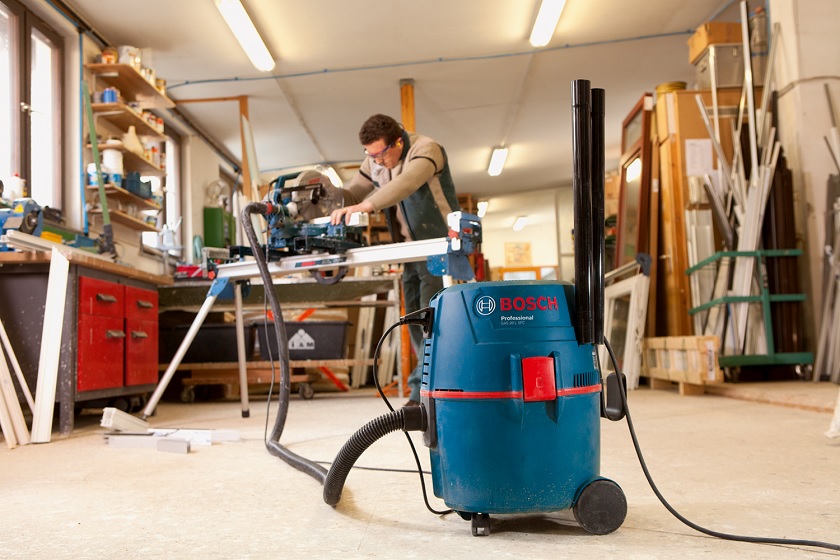
Cleaning at the end of the shift
During a work shift, a significant amount of construction waste accumulates underfoot, and it is unprofitable to spend working time on timely cleaning. At the end of the shift, the waste is disposed of in the usual way. A telescopic tube is connected to a flexible hose, a wide nozzle and the process has begun.
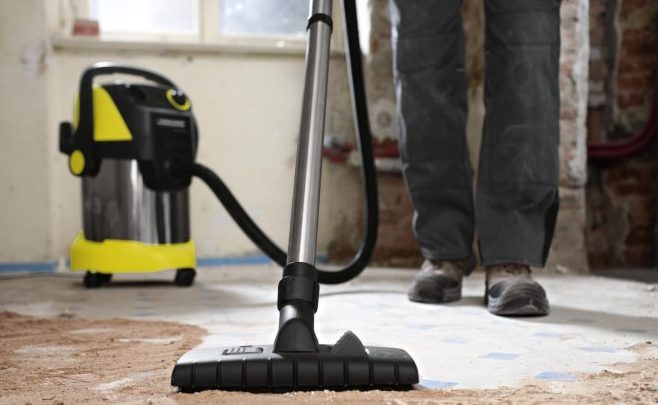
Types of dust collectors and filters
Construction models can be equipped with dust bags or work without bags.
Bags can be made of fabric (reusable) or paper (disposable). Models with aquafilters and cyclones do not need to install bags. Each type of dust collector has its own advantages and disadvantages.
Cloth bags
The most common dust collectors are familiar to all owners of household appliances. When the bag is full of waste, it is removed, cleaned and returned to its place. Once upon a time, sacks were made of satin. Retaining the coarse fraction, this material did not cope well with the fine suspension, which flew back into the room through the exhaust hole. Now for these purposes, a two-layer non-woven material is used, which is capable of holding particles up to several microns in size, significantly increasing the efficiency of work. Cloth bags are durable enough and do not require frequent replacement. This version of dust collectors is low-cost.
Paper bags
Natural consumable - fill and discard. If we take into account the cost of one bag, equal to $ 5, then with an intensive mode of operation, the expenditure of funds for the purchase of one-time dust collectors will very soon override the cost of a vacuum cleaner. In addition, small stones, glass shards and chips can destroy it.
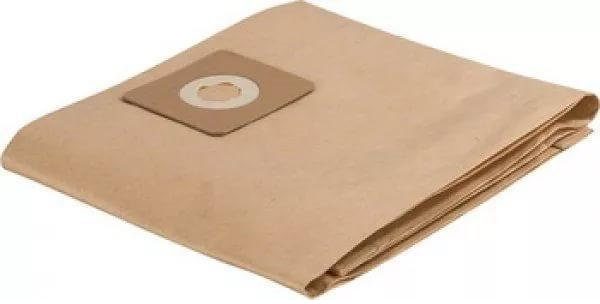
Containers
In cyclonic devices, bags are not required. Waste is collected in a container. The main disadvantage of such a dust collector is the increased noise from the frequent blows of large fragments against the walls of the tank.Devices of this type are of limited scope. With their help, large waste, garbage with a high moisture content, liquid is removed.
Aquafilters
Here, the clogged air passes through the water, where the coarse fraction is deposited. This is the most efficient way to clean the exhaust air. Such models are more expensive than machines with bags and cyclones, and surpass them in weight. The volume of the dust container is small. Water, the only consumable, is not always available and needs to be changed frequently. Such devices are not suitable for removing large volumes of waste.
Fine filters
In addition to fabric dust collectors, vacuum cleaners are equipped with filters that clean the air from residual dust. The materials for their manufacture are nylon, polyurethane and other synthetics. They also have to be cleaned periodically. Otherwise, the suction power drops sharply and the load on the motor increases.

Purpose of construction vacuum cleaners
Waste and debris can be in nature:
- Large and small fractions;
- Finely dispersed;
- Solid and liquid;
- Fire hazardous.
The choice of the type of vacuum cleaner depends on the nature of the waste to be "dealt with".
For dry cleaning
Any type of device can handle such work. The main thing here is sufficient power, the volume of the dust collector (depending on the amount of waste generated per unit of time) and the efficiency of exhaust cleaning. Field of application - removal of fine dust: cement, lime, gypsum and other dry construction mixtures.
For dry and wet cleaning
For such work, models with synthetic filters and devices with an aquafilter are suitable. They can be used to remove dry debris and collect spilled liquid from the floor. To ensure a safe working environment, it is sometimes required to perform wet cleaning in work areas. A washing vacuum cleaner will cope with this work. It is irrational to use it only to remove dry debris.
For cleaning explosive waste
These include:
- Aluminum and zinc powders;
- Suspension of fine coal;
- Small particles of sugar, flour and wood.
For their cleaning, special models are used, the engines of which are not equipped with graphite brushes that give a spark. In order to avoid the heating of flammable dust during suction, such devices must be equipped with a flow rate meter. These are the most expensive models. They are used in specialized enterprises. To remove hot scale and shavings, special heat-resistant devices are used.
How to choose a vacuum cleaner
Before buying such a device, you need to clarify the selection criteria:
- Nature, fractional composition (fine suspended matter, stones) and the amount of debris.
- Operating hours of the device per day or per week.
- Cleaning area (small workshop or production hall).
- Debris removal method (dry, wet, spilled water removal).
Waste hazard class
All industrial wastes are divided into classes depending on the impact they have on the environment and safe working conditions:
- L - low hazard. This includes the bulk of waste during construction work. Simple nylon filters are sufficient to collect and dispose of L - class waste. Maximum allowable emissions into the atmosphere - no more than 1%.
- M - medium hazard. It includes suspension from wood processing, cutting and breaking concrete, nickel, manganese and copper sawdust. Devices for cleaning waste M-hazard class must ensure that the exhaust is cleaned by 99.9%.
- H - high danger. These are small lead and asbestos particles, suspension containing mold, fungus, bacteria and toxic elements. Cleaning of such waste requires the use of special devices equipped with flow rate sensors, which provide air purification at the outlet of at least 99.995%.
- ATEX - explosive and fire hazardous wastes: suspensions of aluminum, coal, flour, sugar, etc. When cleaning them, special electrical safety devices are used, with a class of at least IP 54.
Power and performance requirements
Both parameters are directly related to each other.A more powerful electric drive ensures the highest productivity of the device and prolongs its working life. Average power indicators of construction vacuum cleaners range from 1 to 1.4 kW. This ensures their productivity at the level of 50 l / s (we are talking about the amount of air purified from debris).
Industrial units are in a separate row. These are already more powerful installations, sometimes stationary with an extensive network of pipelines, connection points of the working body in various places of the production facility. The power of such devices can reach 70 kW, and the capacity is 100 l / s or more.
Underpressure
This parameter is measured in millibars and the larger it is, the better the vacuum cleaner "pulls" and the larger the waste it is able to clean up. Building models can generate vacuum up to 250 mbar. If you want to know how efficiently your unit will work, specify what kind of vacuum it creates.
Dust collector capacity
When choosing equipment for this parameter, calculate the amount of waste from your production per unit of time (shift, day). If the volume of cleaning is small, there is no need to purchase a device with a large dust collector. It is better to empty it once a day than to pay extra for an oversized device. Models are equipped with dust collectors with a volume of 20 to 60 liters. Industrial devices contain 100 liters or more, are more expensive, consume a lot of electricity.
Case requirements
It should be impact-resistant, made of metal (preferably stainless steel). Some manufacturers use reinforced plastic. The unit is heavy on its own, and with debris it is even heavier, so when buying it is worth paying attention to the strength of its chassis (wheel bearings), transport handle and the length of the power cord (the more, the better). If you have to work on the decoration of apartments and offices, you should opt for models equipped with a bumper. It will prevent damage to the wall finish in an accidental collision.
Additional functions
Some models are characterized by functions that at first glance are optional, but bring convenience and comfort to the process of their operation. Such devices are more expensive than conventional devices, but they are worth it. Consider what else the buyer should pay attention to:
- Automatic filter cleaning. The function shortens the time required to clean the filters in order to maintain the performance of the vacuum cleaner. It is performed by automatically changing the direction of the air flow.
- Adjustable traction force. Sometimes it is very convenient to increase or decrease the suction power, depending on the amount of waste generated. In addition, as the suction power decreases, the load on the motor and the power consumption are reduced.
- Built-in power outlet. A very convenient function when using carpentry tools with nozzles for removing chips and sawdust. Automatic switching on occurs when you press the start button of the planer, circular saw, etc., powered by a built-in socket. When the tool is turned off, the unit works for some time until the residual waste is removed and automatically turns off. When purchasing such a device, it is necessary to clarify the maximum power of the instrument connected to the outlet.
- Indicator lights inform the user of a clogged hose, a clogged filter, an overfilled dust container.
- Overload protection will keep the device from premature failure of the electric motor.
Top manufacturers
Which vacuum cleaner is better to buy Certainly from the best world manufacturers, the popularity of models of which is based on high quality, expanded functionality, endurance and durability. Here are just a few of them:
- Bort Global is an international group of companies. Power tools, clearing and household appliances.
- Kercher is a German company. The world's largest manufacturer of household and industrial appliances for various purposes, as well as washing equipment. Her popular models are in high demand.
- Bosch is a German company. One of the largest manufacturers of household and professional equipment for various purposes. Doesn't need special advertising.
- Metabo - Germany. Specialization - production of power tools, woodworking, cutting machines and other equipment.
- DeWalt - USA. Manufacture of high-tech tools, equipment, workwear.
- Fubag - Germany. Specializes in the production of professional tools and equipment.
- Husqvarna - Sweden. Manufactures weapons, household and garden equipment, chain saws, vacuum cleaners, etc. All products are of high quality.
Interesting! Husqvarna was founded in the 16th century and specialized in the production of small arms. At the time, her muskets were considered the best in the world.
These are just some of the best manufacturers producing popular high quality construction vacuum cleaners. It is up to you which company to buy the device. Hear tips and tricks from experienced users. When purchasing, carefully read the description, specifications and operating instructions. Find out how much this or that model costs and make the right choice.
Rating of quality construction vacuum cleaners
10. Karcher WD 2
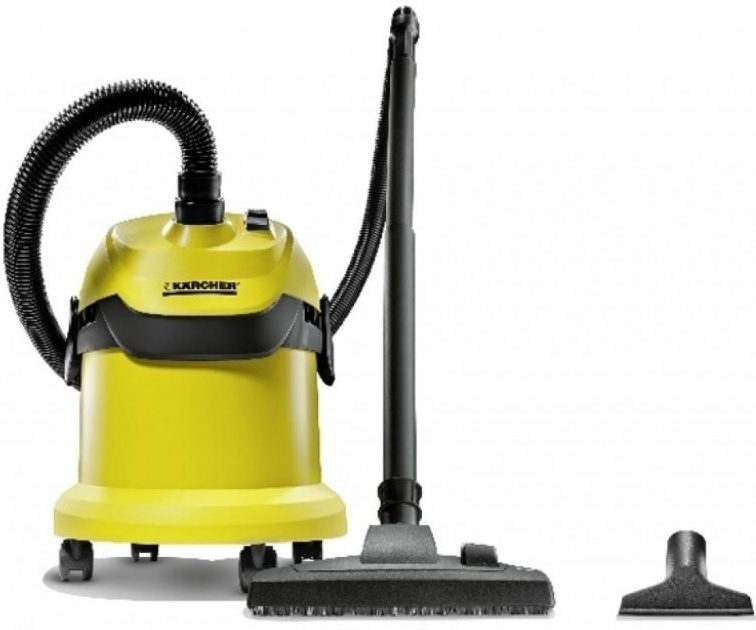
The Karcher WD 2 model opens the overview. The device is inexpensive, lightweight and powerful enough to perform dry and wet cleaning. The volume of the dust container is small and is only 12 liters. Equipped with universal and crevice nozzles. It copes quite well with the function of cleaning construction waste during repairs. In addition, it has one indisputable advantage - an affordable price, averaging 3,391 rubles.
Advantages:
- Easy;
- Compact;
- Inexpensive;
Disadvantages:
- Small amount of dust collector;
- The center of gravity is high, hence poor horizontal stability;
- Short hose length.
| Model name / brand name | Specifications | average price |
|---|---|---|
| Karcher WD 2 1000 W / Germany | Construction vacuum cleaner for cleaning dry and wet waste. Designed to work with paper and cloth bags for collecting dust up to 12 liters. Engine, power 1000 W, hose DN - 35 mm, length - 1.9 m. Package contents: three nozzles for different purposes, paper bag - 1 pc. | 3391 rubles |
9. Bort BSS 1440-Pro
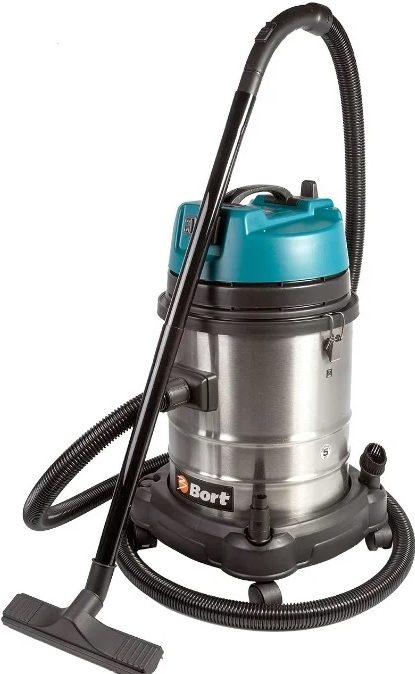
The ninth line of the rating is taken by the product of the international group of companies Bort Global, model Bort BSS 1440-Pro. Carries out dry and wet cleaning. Equipped with a fairly capacious dust collector with a volume of 40 liters. The 1400 W motor provides good vacuum and powerful traction, allowing you to remove even wet sand from summer cottages. A built-in outlet provides convenience when working with a portable power tool. The average price is 7463 rubles.
Advantages:
- Roomy dust collector;
- Large air consumption;
- High performance;
- Not dusty.
Disadvantages:
- Not found.
| Model name / brand name | Specifications | average price |
|---|---|---|
| Bort BSS-1440-Pro / international group of companies | Construction vacuum cleaner for removing wet and dry debris. The dust container holds 40 liters of waste. 1400W motor with power regulator. The maximum air flow does not exceed 38 l / s. Creates a vacuum of 190 mbar. Complete set: flexible hose, 35mm in diameter, two extension tubes and four nozzles. Weight 10 kg. | 7463 rubles |
8. Hammer Flex Pil50A

In eighth place is another model developed by German engineers - Hammer Flex Pil50A. Dust collector with a volume of 50 liters, powerful engine, good vacuum and traction allow you to remove debris, sawdust and collect water from the floor. The presence of a polyurethane filter allows you to work with dry and wet formulations without cleaning. Users love the long enough power cable, the built-in socket, and three different hose nozzles. The average price of this model is 8010 rubles.
Advantages:
- Polyurethane filter;
- Long electrical cable;
- Roomy dust collector;
- Nice design.
Disadvantages:
- There is no automatic filter cleaning function.
| Model name / brand name | Specifications | average price |
|---|---|---|
| Hammer Flex PIL 50 A / Germany | Construction vacuum cleaner for removing dry and wet debris. 1400 W motor, 50 liter dust collector, power outlet. Vacuum 220 mbar. Hose DN 32 mm -3 m, electric cable 7 m. For L-class dust. Weight 11.6 kg. | 8010 rubles |
7. Metabo ASA L PC
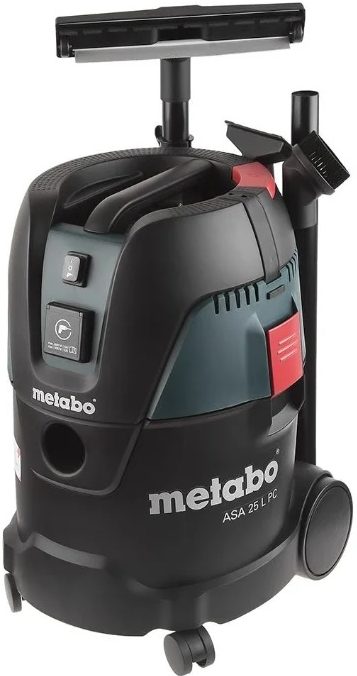
Another German development - Metabo ASA L PC takes seventh place in our rating. Equipped with a less powerful engine, the unit provides a vacuum of 210 mbar and good suction of various waste. A dust collector with a bag can "hide" 25 liters of waste. The built-in socket allows the connection of a portable high power tool. The model performs dry and wet cleaning. Use cloth dust bags to prevent dust emissions. Users appreciate it for its reliable cleaning of construction debris and a high degree of dust removal from exhaust. The average price of the product is 9352 rubles.
Advantages:
- Stylish design;
- High performance;
- Convenient attachment of nozzles and tubes to the body;
- Built-in socket.
Disadvantages:
- Manual filter cleaning.
| Model name / brand name | Specifications | average price |
|---|---|---|
| Metabo ASA 25L PC / Germany | Construction vacuum cleaner for removing dry and wet L-class waste. Dust container - 25 liters, power outlet. 1250W motor. Vacuum up to 210 mbar with air flow up to 60 l / s. Equipped with a hose DN 32 mm, L- 3.5 m, electric cable L- 7.5 m. | 9352 rubles |
6. Nilfisk AERO 21-21

In sixth place is a product from the well-known Danish company Nilfisk AERO 21-21. The 1250 W motor provides a high vacuum of 210 mbar with a small dust collector volume. Hence - a powerful suction of dust and debris during dry and wet cleaning, which is required of him. The device is equipped with a built-in socket and an automatic switch-on function when using a power tool. It shows itself perfectly when used in small carpentry shops. The average price is 9800 rubles.
Advantages:
- Powerful absorption;
- Durable body;
- Stylish design;
- Low weight;
- Built-in socket.
Disadvantages:
- Short hose and power cable;
- There is no automatic filter cleaning function.
| Model name / brand name | Specifications | average price |
|---|---|---|
| Nilfisk AERO 21-21 PC / Denmark | Construction vacuum cleaner for removing dry and wet debris. Dust collector - 20 liters. Equipped with a 1250 W engine, developing a thrust of 60 l / s. Vacuum 210 mbar. Has a built-in socket, flexible hose L - 1.9 m, power cable L - 5 m. | 9800 rubles |
5. Makita VC2512L
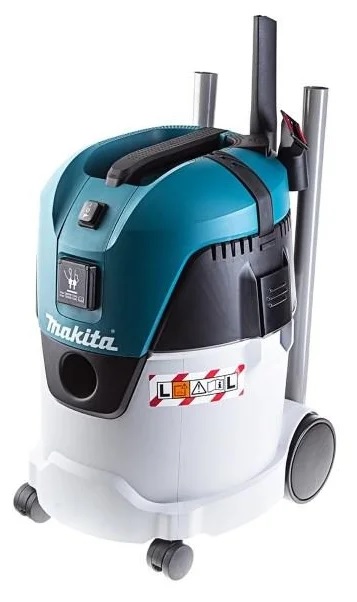
The fifth line of the rating is taken by the product of the Japanese company Makita VC2512L. The device is equipped with a dust collector with a bag of 25 liters. The power of the device is not great, only 1000 W, but it creates a high vacuum and has a powerful suction. The obvious advantages include the ability to clean dry and wet debris, the presence of a built-in outlet and an automatic filter cleaning function. The average price of the model is 9719 rubles.
Advantages:
- High-quality assembly;
- Stylish design;
- Powerful traction;
- Built-in socket;
- Automatic filter cleaning.
Disadvantages:
- Low engine power;
- Short cable;
| Model name / brand name | Specifications | average price |
|---|---|---|
| Makita VC 2512 L / Japan | Construction vacuum cleaner for removing dry and wet debris. Dust collector - 25 l. The developed thrust is 60 l / s with an engine power of 1000 W and a vacuum of 210 mbar. Collects L-class waste and dust. Equipped with a flexible hose DN 32 mm, L- 3.5 m, a 5-meter power cable. Equipped with a power outlet and automatic filter cleaning. Weighs 8 kg. | 9719 rubles |
4. Elitech PS 1260A
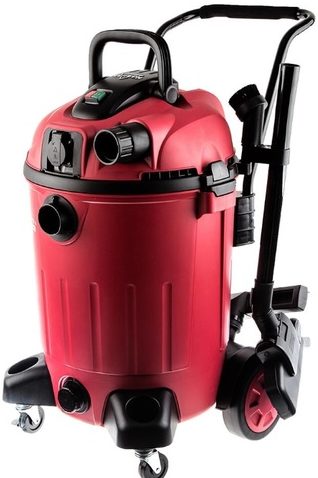
In fourth place is the product of the Russian company Elitech PS 1260A. The model is equipped with a 1200 W motor, which allows a negative pressure of 200 mbar. This is a fairly high figure.An additional plus is the presence of a built-in socket and an automatic switch-on function. The device copes well with garbage collection and has a stylish design. The average price is 9,900 rubles.
Advantages:
- Simplicity and reliability;
- Large volume of dust collector;
- Strong traction;
- Built-in socket.
Disadvantages:
- Short power cable;
- Lack of automatic filter cleaning.
| Model name / brand name | Specifications | average price |
|---|---|---|
| Elitech PS 12160A / Russia | Construction vacuum cleaner for dry waste. It is equipped with a 1200 W engine, a tank with a volume of 60 liters, a power outlet, a DN 40 mm hose, L-3 m, and a D-5 m power cable. Able to create a vacuum up to 200 mbar. Model weight - 14.5 kg. | 9900 rubles |
3. Karcher WD 6P Premium

In third place is Karcher WD 6P Premium. Powerful device with a 30-liter dust collector and a 1300 W motor. Creates a vacuum that allows you to cope with the collection of dry and wet waste of any type in a container. When working with a power tool and generating fine dust, be sure to use a bag. Some users purchase it for the home, like a household one, and use it to clean the sewer. By the way, the effect is amazing. Karcher WD 6P Premium works great with portable power tools. When the power drops, the filter is cleaned by pressing the button on the housing cover. The power control switch is located on the front panel at the top. In addition to the main function, it works as a switch for normal cleaning and working with the tool. The average cost is 13,200 rubles.
Advantages:
- Suction power;
- Dust collector made of stainless steel;
- Stylish design;
- Built-in socket;
- Build quality.
Disadvantages:
- Power cord without automatic rewinding.
| Model name / brand name | Specifications | average price |
|---|---|---|
| Karcher WD 6P Premium | Construction vacuum cleaner for removing dry and wet debris. Dust collector for 30 liters. The model is equipped with a 1300 W motor with power regulation and built-in socket, as well as an automatic filter cleaning system. Complete with hose DN 35mm, L-2.2 m, 6m cable. Model weight - 9.5 kg. | 13,200 rubles |
2. Husqvarna WDC 325 L
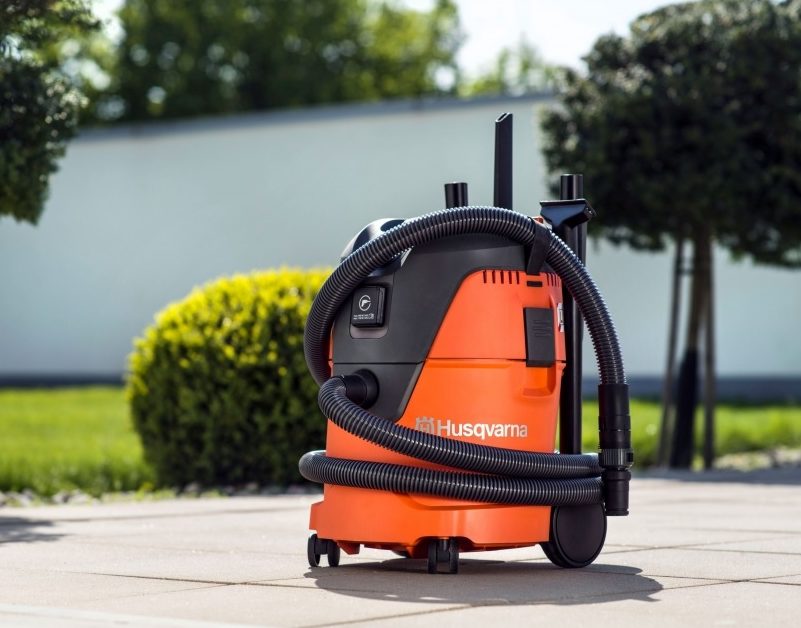
The second line of the rating is occupied by the Swedish model Husqvarna WDC 325 L. The 1200 W motor creates a vacuum of 230 mbar, providing powerful suction of dry and wet debris, as well as the ability to remove water from the floor. The 25 liter plastic dust collector is equipped with a bag for collecting garbage during normal cleaning or when working with a portable power tool, for which a special socket is provided on the case. Built-in filters purify the air by 99.5%. If necessary, during operation, the filter is shaken by pressing the button on the housing cover. The power regulator on the front panel allows you to save energy, extends the engine's service life, and allows you to select the modes of regular cleaning and work with a power tool. The average cost of the device is 15640 rubles.
Advantages:
- Powerful absorption;
- High degree of air filtration;
- Power regulator;
- Excellent blowing performance;
- Stylish design.
Disadvantages:
- High price.
| Model name / brand name | Specifications | average price |
|---|---|---|
| Husqvarna WDC 325 L | Construction vacuum cleaner for cleaning dry and wet waste. Dust collector for 25 liters of L-class dust, built-in socket. Equipped with a 1200 W engine, 62 l / s thrust and 235 mm vacuum. Equipped with a hose DN 32 mm, L-3.5 m, power cable L-5 m. The filter is cleaned in a semi-automatic mode. Model weight - 8.5 kg. | 15640 rubles |
1. Bosch Gas 12-25 PL
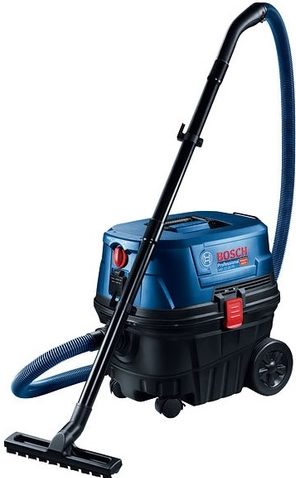
The first place in the rating and the best reviews from customers is received by the Bosch Gas 12-25 PL model, designed for cleaning dry and wet dust. The 1250 W motor with 25 liter dust collector generates a 200 mbar vacuum for powerful dust extraction. Pre-filtration and HEPA filter purify the exhaust by 99.95% for any construction work.Automatic filter cleaning makes it possible to work with the tool without frequent maintenance stops. If this is not enough, then you can use the manual dust shake button on the case cover during operation. The built-in socket can handle any portable power tool up to 2000W. The power regulator can switch the device to the mode of operation with the tool plugged into the built-in socket, as well as to the normal cleaning of the room. The average cost of the model is 14 165 rubles. According to buyers, this is the best value for money.
Advantages:
- Powerful absorption;
- Pre-filtration;
- High degree of air purification;
- Automatic filter cleaning;
- Built-in socket;
- Stylish design.
Disadvantages:
- Short power cable.
| Model name / brand name | Specifications | average price |
|---|---|---|
| Bosch Gaz 12-25 PL / Germany | Construction vacuum cleaner for removing dry dust L-class. Dust collector - 21 liters. The 1250 W motor provides 35 l / s of thrust. Vacuum 200 mbar. The filter is automatically cleaned. A socket for connecting a power tool is mounted in the body. Model weight - 9 kg. | 14165 rubles |
In conclusion, it should be noted that the construction vacuum cleaner is a versatile device. It can be used as a household one, is indispensable in construction, as well as in DIY repair work. The market is saturated with various models, budgetary in price. The purchase of this useful device is available to everyone. We hope that our site will help you determine a worthy model for yourself and avoid mistakes when choosing.












